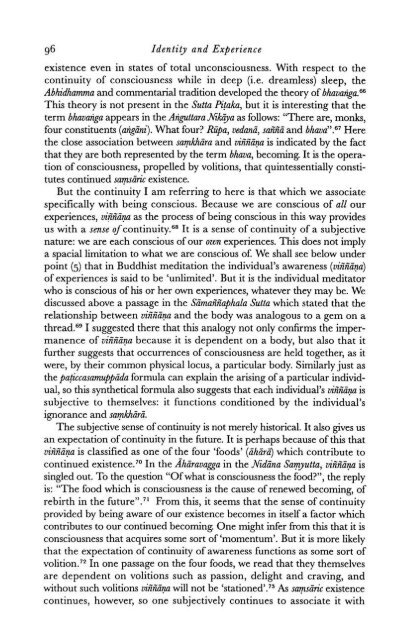Identity and Experience_Hamilton_1996
Identity and Experience_Hamilton_1996
Identity and Experience_Hamilton_1996
Create successful ePaper yourself
Turn your PDF publications into a flip-book with our unique Google optimized e-Paper software.
96 Identi0 <strong>and</strong> <strong>Experience</strong><br />
existence even in states of total unconsciousness. With respect to the<br />
continuity of consciousness while in deep (i.e. dreamless) sleep, the<br />
Abhidhamma <strong>and</strong> commentarial tradition developed the theory of bha~ariga.~~<br />
This theory is not present in the Sutta Pitaka, but it is interesting that the<br />
term bhauariga appears in the Ariguttara Nibya as follows: "There are, monks,<br />
four constituents (arigini). What four? Riipa, vedani, saiin" <strong>and</strong> bha~a".~~ Here<br />
the close association between samhira <strong>and</strong> uin"n"ipz is indicated by the fact<br />
that they are both represented by the term bhava, becoming. It is the operation<br />
of consciousness, propelled by volitions, that quintessentially constitutes<br />
continued samriiic existence.<br />
But the continuity I am referring to here is that which we associate<br />
specifically with being conscious. Because we are conscious of all our<br />
experiences, ui,n"fia~ as the process of being conscious in this way provides<br />
us with a sense of ~ontinuity.~' It is a sense of continuity of a subjective<br />
nature: we are each conscious of our own experiences. This does not imply<br />
a spacial limitation to what we are conscious of. We shall see below under<br />
point (5) that in Buddhist meditation the individual's awareness (vififiina)<br />
of experiences is said to be 'unlimited'. But it is the individual meditator<br />
who is conscious of his or her own experiences, whatever they may be. We<br />
discussed above a passage in the Siman"n"aPha1a Sutta which stated that the<br />
relationship between vin"n"ina <strong>and</strong> the body was analogous to a gem on a<br />
thread.69 I suggested there that this analogy not only confirms the impermanence<br />
of uin"n"ina because it is dependent on a body, but also that it<br />
further suggests that occurrences of consciousness are held together, as it<br />
were, by their common physical locus, a particular body. Similarly just as<br />
the paticcasamuppida formula can explain the arising of a particular individual,<br />
so this synthetical formula also suggests that each individual's uinn"ipz is<br />
subjective to themselves: it functions conditioned by the individual's<br />
ignorance <strong>and</strong> samhzri.<br />
The subjective sense of continuity is not merely historical. It also gives us<br />
an expectation of continuity in the future. It is perhaps because of this that<br />
vin"n"ina is classified as one of the four 'foods' (ihirii) which contribute to<br />
continued existence." In the Ahiravagga in the Nidina Samyutta, uin"n"ipa is<br />
singled out. To the question "Of what is consciousness the food?", the reply<br />
is: "The food which is consciousness is the cause of renewed becoming, of<br />
rebirth in the future".71 From this, it seems that the sense of continuity<br />
provided by being aware of our existence becomes in itself a factor which<br />
contributes to our continued becoming. One might infer from this that it is<br />
consciousness that acquires some sort of 'momentum'. But it is more likely<br />
that the expectation of continuity of awareness functions as some sort of<br />
volition.'* In one passage on the four foods, we read that they themselves<br />
are dependent on volitions such as passion, delight <strong>and</strong> craving, <strong>and</strong><br />
without such volitions uin"fiiga will not be '~tationed'.~~ As samsaric existence<br />
continues, however, so one subjectively continues to associate it with


